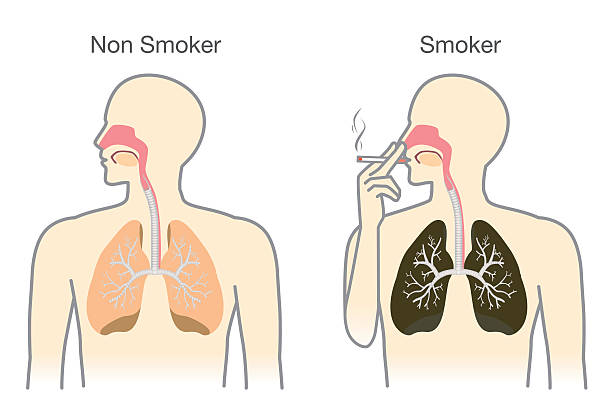Lung Cancer Can Affect Non-Smokers Too, Experts Warn Ahead of Awareness Month

Lung cancer has long been associated with cigarette smoking. For decades, public health campaigns, doctors, and policymakers have focused on tobacco as the single biggest risk factor — and rightly so. But in recent years, oncologists and researchers have raised a critical concern: lung cancer isn’t just a smoker’s disease.
As Lung Cancer Awareness Month approaches, experts are calling for a broader understanding of the disease. Non-smokers are being diagnosed at an alarming rate, and in many cases, they are diagnosed too late. This growing trend highlights a serious need for awareness, early detection, and better access to lung health screening — regardless of smoking history.
A Silent Epidemic Among Non-Smokers
Statistics reveal a striking reality: up to 20% of people diagnosed with lung cancer have never smoked. According to the World Health Organization (WHO), lung cancer remains the leading cause of cancer deaths worldwide, accounting for around 1.8 million deaths every year — and a significant number of these occur in people who have never lit a cigarette.
Dr. Maria Alvarez, a thoracic oncologist at the European Lung Health Institute, explains,
“We often see patients who are completely shocked when they receive a lung cancer diagnosis. They say, ‘But I’ve never smoked!’ The truth is, lung cancer has many causes beyond smoking — and these cases are rising.”
In the UK alone, Cancer Research UK estimates that more than 6,000 non-smokers are diagnosed with lung cancer annually. Similar patterns are seen across the US, Europe, and Asia, suggesting a global shift in the disease’s epidemiology.
What Causes Lung Cancer in Non-Smokers?
Lung cancer develops when abnormal cells grow uncontrollably in the lung tissue, forming tumours that interfere with breathing and oxygen exchange. In non-smokers, these mutations often arise from environmental, genetic, or occupational exposures rather than tobacco. Below are the leading known causes.
1. Air Pollution
Outdoor air pollution is now recognised as a major cause of lung cancer among non-smokers. The fine particulate matter (PM2.5) released from car exhausts, factories, and fossil fuel burning can penetrate deep into lung tissue, triggering inflammation and DNA damage.
The International Agency for Research on Cancer (IARC) has classified air pollution as a Group 1 carcinogen — the same category as asbestos and tobacco smoke. Studies show that long-term exposure to polluted air can increase lung cancer risk by 15–20%, even for people who have never smoked.
Dr. Ethan Mills, an environmental health researcher, notes:
“For urban residents, especially in areas with heavy traffic or industrial emissions, the daily exposure to fine particles can have cumulative effects. The lungs have no filter against microscopic toxins.”
2. Radon Gas Exposure
Radon is a naturally occurring radioactive gas that seeps from soil and rocks into homes and buildings. It’s invisible, odourless, and tasteless — but it’s the second leading cause of lung cancer after smoking, according to the U.S. Environmental Protection Agency (EPA).
When inhaled, radon particles emit radiation that damages lung cells over time, leading to cancer. In fact, radon exposure causes an estimated 21,000 lung cancer deaths per year in the United States alone.
Homeowners are advised to test for radon, especially in basements and lower floors. In some regions, radon testing is mandatory during real estate transactions — but many remain unaware of the risk.
3. Occupational Hazards
Certain professions expose workers to carcinogenic substances such as asbestos, diesel exhaust, arsenic, and silica dust. Prolonged exposure, even at low levels, significantly raises the risk of lung cancer.
For instance:
- Construction workers and miners may inhale asbestos fibres or silica dust.
- Mechanics and drivers can be exposed to diesel exhaust fumes.
- Metalworkers may encounter arsenic compounds and welding fumes.
While safety regulations have improved in many countries, experts warn that occupational exposures remain a serious concern, particularly in developing regions with limited worker protections.
4. Secondhand Smoke
Even if someone never smokes, they can still be affected by tobacco through passive or secondhand smoke exposure. According to the Centers for Disease Control and Prevention (CDC), secondhand smoke causes over 3,000 lung cancer deaths annually in the U.S. alone.
The chemicals in secondhand smoke — including benzene, formaldehyde, and arsenic — can damage DNA and trigger the same carcinogenic processes as active smoking. This is especially dangerous for children and partners of smokers, who are exposed over long periods.
5. Genetic Susceptibility
Some non-smokers develop lung cancer due to inherited genetic mutations or spontaneous changes in DNA. These mutations can affect how cells grow and repair themselves, making some individuals more prone to cancer even without environmental triggers.
One common mutation involves the EGFR (epidermal growth factor receptor) gene, which is often found in younger, female non-smokers with adenocarcinoma — the most common type of lung cancer in non-smokers.
The good news: advances in genetic testing and targeted therapies now allow doctors to personalise treatment for patients with specific mutations, improving survival rates.
6. Indoor Pollutants and Cooking Fumes
In many Asian, Middle Eastern, and African countries, indoor air pollution from burning coal, wood, or biomass for cooking and heating is a major health threat. The World Health Organization estimates that over 3 billion people are exposed to these toxic fumes daily.
Unventilated stoves release carcinogens such as benzene and formaldehyde, leading to a higher prevalence of lung cancer — particularly among women who spend more time cooking indoors.
The Hidden Danger of Late Diagnosis
A key challenge with lung cancer in non-smokers is late detection. Because most people associate the disease with smoking, non-smokers often ignore early symptoms or are misdiagnosed initially.
Typical warning signs include:
- Persistent cough lasting more than three weeks
- Shortness of breath
- Chest pain or tightness
- Unexplained weight loss
- Fatigue
- Coughing up blood (haemoptysis)
Dr. Helen Carter, a respiratory specialist, stresses:
“Many non-smokers don’t suspect lung cancer because they think it ‘can’t happen to them.’ Unfortunately, by the time they seek medical help, the cancer may already be advanced.”
In fact, nearly 60% of lung cancers in non-smokers are diagnosed at Stage III or IV, when curative treatment becomes much more difficult. This is why awareness and early screening are vital.
Rethinking Screening and Awareness
Current screening programmes — such as low-dose CT (LDCT) scans — are typically recommended for people with a history of heavy smoking. But many experts now argue that this approach overlooks a growing population of at-risk non-smokers.
Emerging research suggests that genetic markers, environmental exposures, and air quality data could be used to develop broader screening criteria in the future.
Public health organisations are beginning to adapt. In the UK, the NHS has piloted Targeted Lung Health Checks for people aged 55–74, regardless of smoking history, in high-risk areas. Meanwhile, scientists are exploring blood-based biomarkers and breath analysis as non-invasive tools for early detection.
How Awareness Month Is Changing the Conversation
Lung Cancer Awareness Month, observed every November, has traditionally focused on anti-smoking campaigns. But in recent years, advocacy groups and medical societies have expanded their messaging to highlight lung cancer in non-smokers.
The goal is twofold:
- Reduce stigma — reminding the public that anyone with lungs can develop lung cancer.
- Promote early detection — encouraging people with persistent symptoms to get checked, even if they’ve never smoked.
Organisations like the Global Lung Cancer Coalition (GLCC) and Lung Cancer Foundation of America (LCFA) are leading awareness drives with hashtags like #LungsMatter and #AnyoneWithLungs. These campaigns are helping to reshape public understanding and compassion for all patients.
Treatment Advances Offer New Hope
While lung cancer remains one of the deadliest cancers, medical breakthroughs are improving outcomes, especially for non-smokers who often have distinct genetic profiles.
1. Targeted Therapy
For patients with mutations such as EGFR, ALK, or ROS1, targeted drugs can block cancer growth more precisely than chemotherapy. Examples include osimertinib (Tagrisso) and alectinib (Alecensa). These treatments have significantly extended survival times in non-smokers with advanced lung cancer.
2. Immunotherapy
Drugs like nivolumab (Opdivo) and pembrolizumab (Keytruda) harness the immune system to recognise and attack cancer cells. Immunotherapy has revolutionised treatment for many patients, offering longer remissions and fewer side effects.
3. Personalised Medicine
Genetic testing is now a standard part of diagnosis. Oncologists can tailor treatment plans based on a patient’s tumour profile, ensuring the most effective therapy with the least toxicity.
4. Improved Surgery and Radiotherapy
Minimally invasive surgeries and precision radiotherapy (such as stereotactic body radiation therapy, SBRT) allow doctors to target tumours accurately while preserving healthy tissue — crucial for non-smokers with good baseline lung function.
The Emotional and Social Side: Breaking the Stigma
Lung cancer patients who have never smoked often face a painful stigma. Society tends to view lung cancer as a “self-inflicted” disease, leading to isolation and shame for those who never used tobacco.
Patient advocate Claire Davies, diagnosed at 39 despite never smoking, shared:
“When people hear I have lung cancer, the first question they ask is, ‘Did you smoke?’ It’s heartbreaking. We need to change that narrative — lung cancer can affect anyone.”
Awareness campaigns are increasingly focusing on compassion, inclusivity, and education. The more people understand that lung cancer is not just a smoker’s disease, the easier it becomes to fund research, support patients, and detect cases earlier.
Prevention and Early Detection: What You Can Do
Even if you’ve never smoked, there are steps you can take to protect your lungs and reduce risk:
- Test your home for radon. Affordable radon testing kits are widely available. If levels are high, install ventilation systems to reduce exposure.
- Avoid secondhand smoke. Encourage smoke-free homes and public spaces.
- Limit exposure to air pollution. Check air quality indexes and avoid outdoor exercise near traffic during high pollution days.
- Maintain indoor air quality. Use ventilation when cooking and avoid burning wood or coal indoors.
- Use protective gear at work. If you’re exposed to dust, fumes, or chemicals, always wear safety masks and follow workplace safety regulations.
- Stay informed about family history. If lung cancer runs in your family, speak to your doctor about genetic testing or early screening.
- Monitor persistent symptoms. Don’t ignore a chronic cough, breathlessness, or chest pain — early consultation can save lives.
The Future of Lung Cancer Research
Scientists are now looking beyond smoking to understand how other factors — from microbiome changes to immune system dysfunction — might influence lung cancer development.
Promising areas of research include:
- Liquid biopsies: detecting cancer DNA fragments in the bloodstream for early diagnosis.
- AI-based imaging tools: improving the accuracy of CT scan interpretation.
- Preventive vaccines: experimental studies are underway to prevent recurrence in high-risk individuals.
Dr. Anil Kumar, a leading oncologist in Singapore, believes we’re entering a new era of understanding:
“In the next decade, we’ll see lung cancer defined not by smoking status, but by its molecular and environmental fingerprints. That shift will save lives.”
Conclusion: Awareness Saves Lives
As Lung Cancer Awareness Month approaches, experts are urging the public to remember one crucial truth: anyone with lungs can get lung cancer.
While smoking remains the leading cause, growing evidence shows that environmental factors, genetics, and occupational hazards also play powerful roles. Non-smokers are not immune — and they deserve equal attention, screening, and empathy.
Early detection is key. If symptoms persist, don’t wait. Speak to your healthcare provider, get screened, and take steps to protect your lungs.




